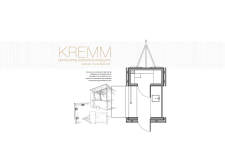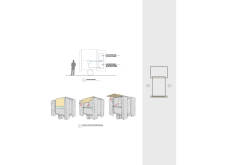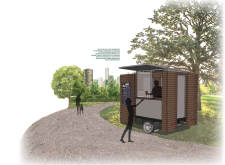5 key facts about this project
The function of the project extends beyond mere shelter; it functions as a dynamic space for [describe the primary use of the building, e.g., residential living, community engagement, workspace]. Every element within the design has been carefully considered to ensure it fulfills both practical and experiential needs. The layout encourages [discuss how these aspects influence the user experience, such as social interaction, privacy, or productivity], which reflects a deep understanding of contemporary living patterns.
The important parts of the project demonstrate a meticulous approach to architectural design. At the entrance, the transition between the exterior and interior is marked by [describe features like overhangs, materials, or lighting that create a welcoming ambiance]. This approach establishes a sense of arrival and draws occupants into the heart of the space. Inside, the floor plan is configured to promote an open yet defined arrangement, allowing for seamless movement between the main living areas, such as [list key spaces like the kitchen, living room, dining areas].
Material selection plays a vital role throughout the project, with careful attention given to both durability and aesthetic contributions. Concrete serves as a fundamental building block, providing structural strength while also offering a modern visual language. The use of glass enhances the interaction with light, inviting natural illumination into the spaces and fostering a connection with the outdoors. Notably, [mention specific glass types or applications that are particularly effective, such as large sliding doors or floor-to-ceiling windows] create opportunities for expansive views and an influx of fresh air.
Wood accents add warmth and texture, enriching the interior environment. The incorporation of [specify types of wood or applications, such as flooring or cabinetry] not only softens the overall aesthetic but also reinforces the intention of creating a welcoming home. Attention to sustainable design manifests through careful material choices, including [list other sustainable materials or technologies used, such as recycled elements or energy-efficient systems], aligning the project with contemporary environmental principles.
Uniquely, the design showcases innovative approaches to [discuss specific design elements or strategies that are not widely employed], such as [describe features that set the project apart, like green roofs, rainwater management systems, or modular layouts]. These aspects reflect a commitment to forward-thinking architecture, addressing issues of resource conservation and ecological sensitivity within the built environment.
The relationship between indoor and outdoor spaces is skillfully articulated, with [discuss features such as terraces, balconies, or outdoor living areas] that extend the living areas into nature. This fluid transition not only enhances the spatial experience but also engages occupants with the surrounding landscape, encouraging outdoor activities and interaction with the environment.
Exploring the architectural plans, sections, and design iterations provides deeper insights into the design process and the rationale behind various choices made throughout the project. The detailed architectural sections reveal how the design interacts with light, airflow, and topography, while the plans give a comprehensive view of the spatial organization and functional relationships among the spaces.
In summary, this project stands as a thoughtful response to its context, prioritizing both human and environmental needs through careful design choices. It serves as a model for modern architecture that emphasizes sustainability, functionality, and aesthetic coherence. For those interested in a deeper exploration of this architectural project, examining the architectural plans, sections, and detailed designs will offer a more comprehensive understanding of the underlying ideas and methodologies that shaped this innovative design.


























